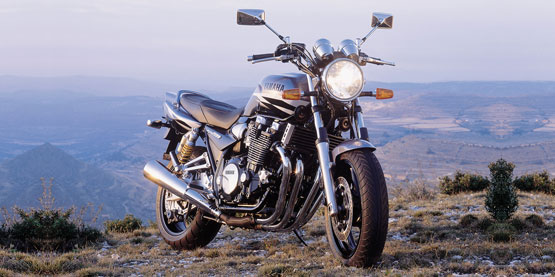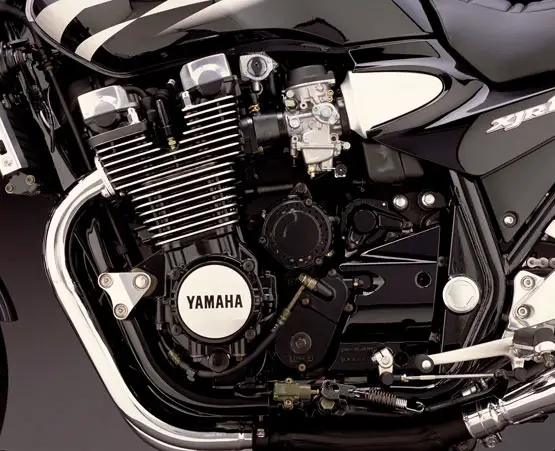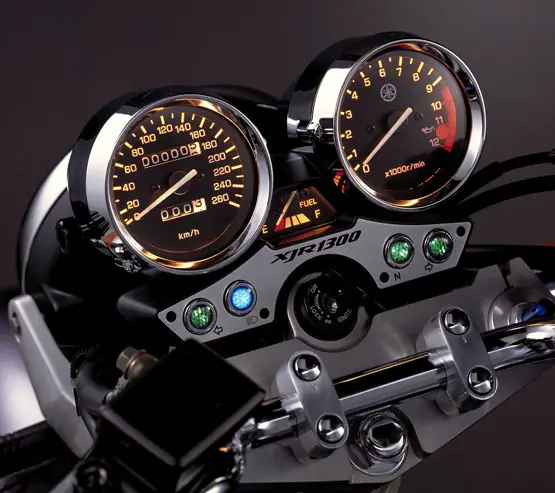Back to the Model History Timeline Review Page
Yamaha XJR1300 – The Silent Evolution
Page 2 of 7
<< Page Back – Page Forward >>
Yamaha XJR1300 series model history timelines
Yutaka Kubo likes big bikes and XJR 1300 is a classic big bike to him. This bike has archetype looks, with the massive air-cooled engine and the conventional shape of tank, seat and sidecovers. In spite of the conventional looks XJR 1300 hidden spec is modern technology.
Kubo explains: “Most of the various improvements for the 2002 model you will not see at first glance. For example, we changed the fuel tank, side cover and seat and handlebar, because we wanted to locate the rider further forward. Reason are better handling character and more weight on the front wheel. On the other hand our designers did not want to alter the characteristic looks of that long life model. So I bet, most bikers will not recognise this at first.”
Indeed XJR 1300 has undergone a real model improvement in many aspects. “The major target for the changes is to improve handling and riding feeling on winding country lanes, the typical terrain of XJR 1300. The handling improvements are also quite helpful in city traffic of course. The bike flips much easier into corners and filtering through traffic makes you feel riding a much smaller machine”, says Oliver Grill, product planner at Yamaha Motor Europe and former owner of an XJR 1200.
XJR 1200 was launched in 1995 and established itself as a powerful naked muscle-bike for people who enjoy the torque of a big displacement engine and a relaxed riding feeling without sacrifice in street sport function. Over all these years the XJR concept has matured and many improvements have been made, such as the displacement increase to 1300 cc in 1999.
“Even as being a big bike, we ourselves felt when riding country lanes around our plant here in Iwata, that XJR should benefit from the knowledge in development of our sport bikes like Fazer or YZF-series. And I believe the new model, even looking like a traditional machine, incorporates what we call ‘YAMAHA handling’. The bike is state of the art,” says Yutaka Kubo who has also led the development of Fazer 1000 (see archive section) and was involved in many 4 cylinder sport bike projects in the past.
To achieve this lighter handling, next to the changed riding position, weight was reduced by 6 kg from 230 to 224 kg. A few years ago this was the figure for big supersport machines.
To support the improved handling the suspension saw an upgrade too: front fork and rear suspension settings are modified to ensure better road holding. Both wheels are lighter to support suspension accuracy with their lowered unsprung weight.
On the other hand the rear wheel axle has increased diameter and the swingarm pivot section has been modified for increased stiffness.
Even the engine was under scrutiny: new carburator, in combination with new camshaft profile have resulted in a better torque particular in low and mid range. “This makes riding on country lanes a real pleasure. Just shift to 4th or 5th gear and roll along with always plenty of pulling power when you need it,” says Oliver with a smile.
“It is interesting to see the popularity of XJR has been stable both in Europe and also in Japan,” adds Tony Maeda, product planning manager at Yamaha Motor Europe. “In particular in Japan, experienced motorcyclists favour XJR, since the machine is a pleasure on Japans smaller roads in spite of the relatively high density of traffic there. With its powerful engine and the agile handling, XJR somehow transfers coolness when in a sandwich between cars and also lets you easily escape by overtaking when you activate its torque and power. And like a custom concept, XJR is an ideal basis for personal customisation. There are plenty of accessory companies you can choose from to change technical parts as well as styling parts to make your XJR as unique as you like.”
The silent evolution of XJR 1300 shows the commitment of engineers and planners to guarantee constant improvement of Yamaha models of many years, rather than changing bikes directions or styling just for changes sake. We think matured motorcyclists will appreciate this attitude.



